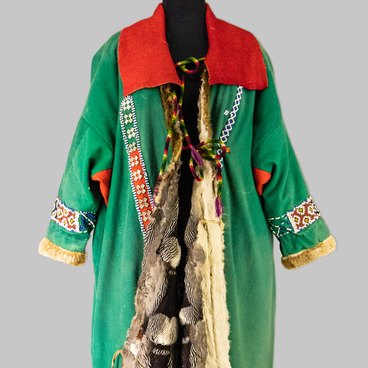At the exhibition, among other exhibits there is a popular print Imperial Highness Heir Crown Prince Nikolai Aleksandrovich - a half-length image of the heir to the throne of the Russian Empire. The portrait was given by Crown Prince Nikolai Aleksandrovich himself to the Tobolsk Provincial Museum, and installed ceremoniously in the building on July 11, 1893.
The history behind this gift began two years earlier, on July 10, 1891 when, during his stay in Tobolsk during his eastward journey, Nikolai Aleksandrovich visited the museum and examined its exposition. At the request of the museum committee, on August 31st, 1891, Nikolai Aleksandrovich took the institution under his patronage, and it remained there until the end of his reign. A high-level status was conferred upon the Tobolsk Provincial Museum, and it became the only museum in Russia honored with participation on the part of the imperial family.
In the portrait, Nikolai Aleksandrovich is depicted in a mountain suit - a Chokha. The Chokha was comfortable for riding, and it did not restrict movement when walking and climbing mountains. To accomplish this, the side seams stopped at a distance of 10–12 cm from the bottom of the garment. For the same reason, the Chokha went down to just below the knees. On both sides of the Chokha, they sewed on the cartridge belt, which was called by another name: gazyr. Men carried bullets in it in wartime, and shell casings in peacetime. Under the Chokha, the successor to the throne wears a Cossack undertunic - this resembles a buttonless shirt, men’s everyday home and work clothes. It was sewn no higher than the knees, and from the collar to the waist was very carefully fitted to the person’s body, tightly hugging the torso - this was how the severity of the uniform was emphasized. One of the inscriptions on the portrait (Chromo-Lith. M.T. Solovyev, M.T. Solovyev, Dolgorukovskaya Street, Lesnoy Lane, owner D. in Moscow) indicates that it was printed in the printshop owned by Mikhail Solovyev in Moscow in 1888.
Mikhail Timofeyevich Solovyev (1853–1930) was born in the village of Shulgino, Sinkovskaya District (present-day Moscow Region) into a peasant family. Like many peasant teenagers, he went to work in Moscow, got a job as an ‘errand boy’ in the printing house owned by Ivan Sytin, and then worked in lithography making sketches on stone. Soon he started his own lithographic business, quickly became wealthy, and then acquired several more printshops in Moscow. As a philanthropist, Solovyev did a lot for education and culture: he paid for two schools to be built in the district’s center of Sinkovo, and then in Turbichevo and Podvyaznov. He contributed 10,000 rubles to build a male secondary school in Dmitrov.
The history behind this gift began two years earlier, on July 10, 1891 when, during his stay in Tobolsk during his eastward journey, Nikolai Aleksandrovich visited the museum and examined its exposition. At the request of the museum committee, on August 31st, 1891, Nikolai Aleksandrovich took the institution under his patronage, and it remained there until the end of his reign. A high-level status was conferred upon the Tobolsk Provincial Museum, and it became the only museum in Russia honored with participation on the part of the imperial family.
In the portrait, Nikolai Aleksandrovich is depicted in a mountain suit - a Chokha. The Chokha was comfortable for riding, and it did not restrict movement when walking and climbing mountains. To accomplish this, the side seams stopped at a distance of 10–12 cm from the bottom of the garment. For the same reason, the Chokha went down to just below the knees. On both sides of the Chokha, they sewed on the cartridge belt, which was called by another name: gazyr. Men carried bullets in it in wartime, and shell casings in peacetime. Under the Chokha, the successor to the throne wears a Cossack undertunic - this resembles a buttonless shirt, men’s everyday home and work clothes. It was sewn no higher than the knees, and from the collar to the waist was very carefully fitted to the person’s body, tightly hugging the torso - this was how the severity of the uniform was emphasized. One of the inscriptions on the portrait (Chromo-Lith. M.T. Solovyev, M.T. Solovyev, Dolgorukovskaya Street, Lesnoy Lane, owner D. in Moscow) indicates that it was printed in the printshop owned by Mikhail Solovyev in Moscow in 1888.
Mikhail Timofeyevich Solovyev (1853–1930) was born in the village of Shulgino, Sinkovskaya District (present-day Moscow Region) into a peasant family. Like many peasant teenagers, he went to work in Moscow, got a job as an ‘errand boy’ in the printing house owned by Ivan Sytin, and then worked in lithography making sketches on stone. Soon he started his own lithographic business, quickly became wealthy, and then acquired several more printshops in Moscow. As a philanthropist, Solovyev did a lot for education and culture: he paid for two schools to be built in the district’s center of Sinkovo, and then in Turbichevo and Podvyaznov. He contributed 10,000 rubles to build a male secondary school in Dmitrov.


